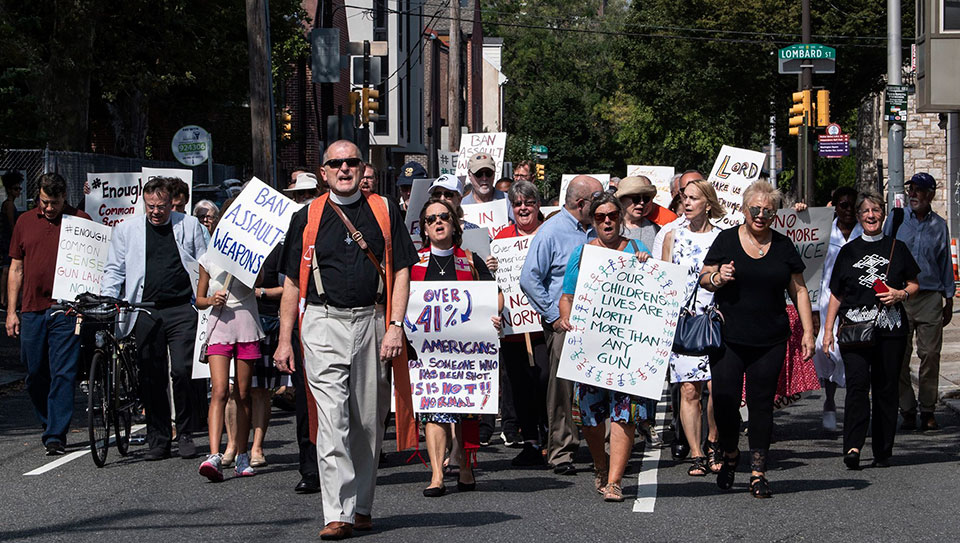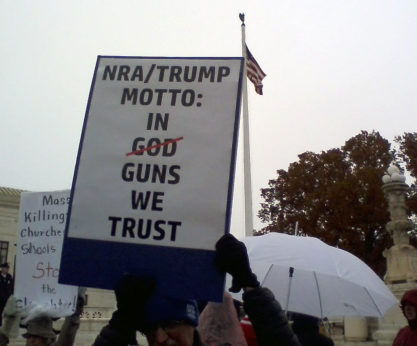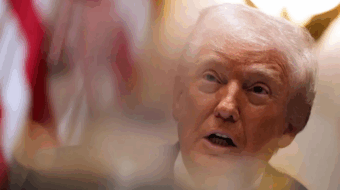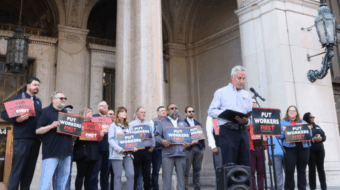
WASHINGTON—For a case with such huge consequences, the nine justices of the U.S. Supreme Court—and lawyers from both sides—talked around the real issue in the court’s biggest gun rights case in 11 years: Whether states and cities and towns and villages could write their own gun-control laws, or not.
And that issue was the implication of the gun lobby’s challenge to a New York City law, since overridden by the state, restricting individual gun ownership to homes or licensed gun ranges, but not anywhere else. The GOP Trump administration joined the National Rifle Association in arguing to the justices that state and local governments can’t regulate guns anywhere at all.
The justices and the attorneys spent much of their 67-minute session on Dec. 2 debating whether to throw the case out, since the later state law repealed the Big Apple ordinance the notoriously right-wing gun lobby challenged.
Most of the rest of their time was spent discussing the old New York City law, and whether rules implementing it let a gun owner stop briefly—for a cup of coffee—or a longer time, at his mother’s house, while traveling between home and a gun range.
But what is really at issue—and the 1,000 demonstrators outside the court, as well as briefs from the National Education Association and March For Our Lives, knew it—is whether any state or local gun law is legal under the 2nd Amendment to the Constitution and its “right to keep and bear arms.”
The author of that 5-4 Heller decision in 2008, the late conservative Justice Antonin Scalia, wrote states and cities could impose some reasonable restrictions controlling guns, but that people had unlimited gun rights in their own homes. The NRA said in its briefs that Heller means gun owners should have unlimited gun rights everywhere. So did its attorney, right-wing advocate Paul Clement, a former top GOP political appointee.
“I don’t think at this late stage we are still being offered unrestricted access,” to having guns everywhere, Clement, representing the NRA, told Justice Sonia Sotomayor, a New York City native. “And I think it’s important to understand.”
But that’s what the state’s override of the city law did, Sotomayor told Clement earlier.
“What you’re asking us to do is to take a case in which the other side”—New York City and state—“has thrown in the towel and completely given you every single thing you demanded. You’re asking us to opine on a law that’s not on the books anymore…not because of something necessarily the city did but because the state…changed the law and prohibited them from doing.”

The demonstrators outside and the friend-of-the-court briefs inside, which never came up in the discussion, didn’t miss the point about the threat to all state and local gun control laws. The dangerous consequences of lack of controls were reinforced simultaneously, though nobody in or out of the court knew it: Milwaukee County police shot, wounded, and arrested a 17-year-old boy who unholstered his pistol and prepared to open fire at his high school. He’s in stable condition. The school was first on lockdown and the students were then sent home for the day. That terrifying scene occurs all too often, speakers outside the court said.
“The NRA has not abandoned its unrestricted view of the Second Amendment,” Rep. Anthony Brown, D-Md., a former state legislator and lieutenant governor, told the 1,000-plus pro-gun-control crowd braving rain and occasional sleet outside the Supreme Court building. “It’s tirelessly worked to stop all gun control laws” both on Capitol Hill and in states. “These are the laws that are at risk.”
“We want safety,” said Ruth Glenn, an African American and director of the National Coalition Against Domestic Violence. “I did everything and thought I was safe” in the Detroit suburbs. But her violent domestic partner first kidnapped her and in a later blowup, “I was shot three times and left for dead. We want safety. Women and children are at risk. Entire communities are at risk.”
In its friend-of-the-court brief, the National Education Association, the nation’s largest union, said kids and teachers are at risk. NEA and more than a dozen other gun control groups, including student-led March For Our Lives, sided with New York. So did Congressional Democrats. Their foes, led by other right-wing think tanks and Congressional Republicans, sided with the NRA.
The Democratic-run House passed gun-control legislation earlier this year, on a virtual party-line vote. It’s going nowhere in the GOP-run Senate. Majority Leader Mitch McConnell, R-Ky., calls it “socialism.” He’s also a top recipient of past NRA campaign contributions.
“NEA has a deep and longstanding commitment to ensuring every child has access to a high-quality public education. A quality education depends on many factors, but most fundamentally on student safety. All students and education employees must be able to learn and work and live in environments free of the threats posed by gun violence,” the union wrote.
In the 11-year-old pro-gun rights case, Scalia “properly acknowledged both that ‘laws forbidding the carrying of firearms in sensitive places’ are presumptively constitutional and that schools are quintessentially ‘sensitive places,’” NEA said.
The NRA and its allies “now urge” the justices “to effectively disregard the assurances” then “about the validity of these important gun-violence prevention measures and, instead, to read the Second Amendment to invalidate any firearm restriction that does not have a close historical analog or that otherwise fails so-called ‘strict scrutiny’” by judges.
And, in plain English, virtually all rules, from any government, that come under judges’ “strict scrutiny,” flunk, NEA said. The result, the union forecast, would be a disaster in schools.
“Such an expansive conception of each individual’s right to bear arms would imperil longstanding restrictions—including those on the carrying of firearms in and around schools—that protect children and the educators who teach them from harm.
“NEA submits such an approach to the constitutional validity of sensible firearms regulations is both dangerous and unwarranted. Children are uniquely vulnerable to gun violence. Those exposed to gun violence suffer physically, emotionally, and academically. And such harms are not limited to children who suffer, or even witness, gun violence directly. They extend to all children in a community affected by gun violence.”
None of this, however, came up in the court on Dec. 2. The justices will decide the case sometime next year, right in the middle of the 2020 election campaign. And that led Teachers (AFT) President Randi Weingarten, speaking outside to the rain-and-sleet-soaked crowd, to predict Trump and the GOP would suffer at the polls by allying themselves with the gun lobby.
“We need to act across the country,” declared Weingarten, a strong proponent of tough gun controls. “Are you ready to act?” she asked. “Yes,” the crowd cheered. “Are you ready to act through the November election?” “Yes!”










